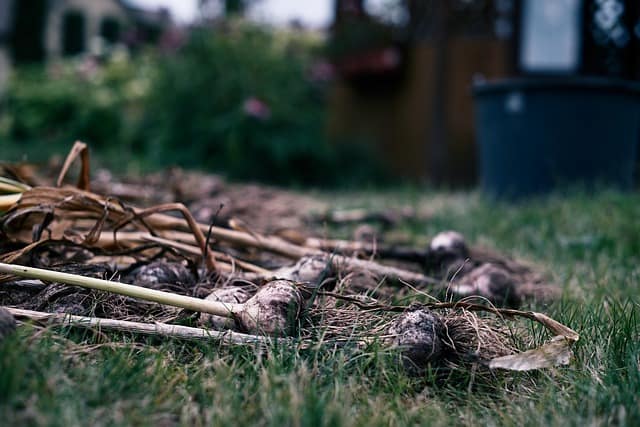
QUESTION: Do I have to wait, or can I eat garlic straight from the ground in my garden? I’ve heard about letting garlic dry, or cure, but I’m not sure whether this is necessary. — Sara C.
ANSWER: Yes, you can eat your homegrown garlic immediately after harvesting. Keep reading to find out what curing is and why some gardeners choose to cure their garlic. Then we’ll discuss the storage options for fresh and cured garlic.
What Is Curing Garlic?
Curing garlic is a simple process of sitting the heads of garlic out to dry. The reduced moisture level in the garlic heads means they will stay fresh for longer. As the garlic dries, its skin forms a tight protective layer to keep out mold and moisture.
Why Do Gardeners Cure Garlic?
Curing garlic results in heads that last a great deal longer than when garlic is used fresh and not cured. Fresh garlic has a shelf life of about three weeks maximum, whereas cured garlic remains fresh for up to six months. By curing garlic, gardeners are ensuring they’ll have access to homegrown garlic throughout the winter months instead of enjoying a windfall of fresh garlic in the middle of the summer.

How to Cure Garlic
The first step to take when you’re curing garlic happens as you collect the harvest: don’t trim the leaves or roots of your garlic plants. You’ll need them attached for the curing stage. When garlic is being harvested for more immediate use, these parts of the plant are removed for tidiness.
Next, you’ll need to choose a location to keep your garlic while it cures. For best results, choose a dry location that’s shady or protected from the sun and gets good air circulation. But you’ll start the garlic in another location: somewhere elevated that gets indirect or dappled sunshine. Too much direct sunlight will cook garlic or scald it, which has a really negative effect on flavor. Consider using a table or rack inside a garage or under a tree for this first step.
There’s no need to clean your garlic to remove dirt before it goes through the curing process. Lay them out on the elevated surface you chose in a single layer, with plenty of space around each head of garlic. Don’t cluster them too closely together or lay them in a pile.
The curing process can take anywhere from two weeks to two months, depending on your climate and the spot you chose. Locations that are warm and dry can cure garlic more quickly than those that are wetter and more humid. Garlic that is completely cured will have leaves that are brown and dried out and roots that are withered and feel stiff.
How to Store Fresh Garlic
This may come as a surprise, but you don’t need to keep bulbs of garlic fresh from the garden in the refrigerator. Exposure to the light and moisture your garlic would encounter in the fridge can cause the bulbs to get moldy or start sprouting.
Instead, keep garlic at room temperature in a dark, dry spot where it will get lots of air circulation. Examples include a paper bag (left open) or wire basket that you keep on the shelf in the pantry or in a cupboard.
Garlic stored this way will stay fresh for up to three weeks, if the skin is intact. However, once the papery skin has been opened and cloves of garlic have been taken off the bulb, the garlic will only last for seven to 10 days. Whether you crack open a head of garlic yourself or the skin is damaged another way, you’ll still need to use the garlic within seven to 10 days.
You do have more options when it comes to storing the garlic you grow. At the end of our article on ways to use homegrown garlic, you’ll find a list of ways to preserve garlic that are a little more unexpected. For example you can make your own garlic powder, use garlic in dry rubs or seasoning blends, and make garlic-infused oils or vinegars. You can even make decorative garlic braids if you leave the foliage intact.
We hope this article has helped answer your question and give you some more information. To review in short, yes—you can eat garlic immediately after harvesting. However, you also have the option of curing garlic, or allowing it to dry, to make it last up to six months instead of just seven to 10 days.
Learn More About Harvesting and Storing Garlic
